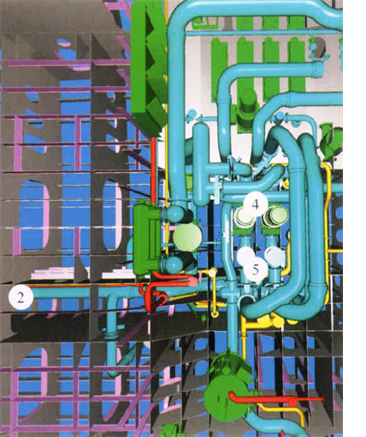The ballast arrangement
The ballast arrangement
The ballast system is used to pump seawater (weight) in or out of the ballast tanks. The rules for the ballast system are less stringent than the rules for bilge systems. Reasons for taking ballast on board or shifting ballast once it is on board are:
-
to improve stability of the ship, especially when the ship is not carrying cargo

-
to put the ship deeper in the water, to improve sea-keeping.
-
to alter the trim
-
to reduce bending moments or shear forces
-
to control the list during loading and discharge. Many ships use an anti-heeling system for this purpose
-
to improve manoeuvrability.
An anti-heeling system is used to minimize the list in port. Pumps with a large capacity (1000 m3/hour) are installed between two tanks (one port side and one starboard).
These pumps can transfer water from one tank to the other at great speed. The system is fully automatic and much used on ships with cranes, on container vessels and Ro-Ro vessels to reduce the list that can occur during cargo handling.
Fore and aft peak tanks, deep tanks, double bottom tanks, and wing tanks are usually used for ballast water, depending on the ship's type.
Bulk carriers often use one of the holds for ballast, during a ballast voyage.
An advantage of using ballast instead of fuel in the double bottom is that welding is allowed on the tank top.
The designer determines the ballast capacity to meet minimum operation draft requirements imposed by Class / IMO. The duration of the voyage and the purpose of the ship is taken into account when deciding on the available space for ballast and the capacity of the ballast pumps.
In small ships, the ballast pumps are usually suitable as bilge pumps.
This makes the ballast system an integrated part of the bilge arrangement, to the extent that a ballast pump may even serve as main bilge pump.
Unlike the valves in the bilge arrangement, the valves in the ballast arrangement have to be two-way valves as the tanks must be filled and emptied.
Double bottom tanks, and to a lesser extent in multipurpose ships, the wing-tanks can be filled directly from sea through the sea inlet, without using the pump.
Nowadays the ballast system is often designed as a ring main.
Remote controlled valves are used to empty or fill the ballast tanks.
Ballast lines inside the double bottom may be made of synthetics.
The bulkhead penetrations have to be steel for fire safety.
Ballast / salt water cooling water system seen from three views.
1. Ballast pumps, valves in engine room
2. Main ballast line to tanks
3. Crossover to side tanks
4. Ballast pumps
5. Pump inlet filters
Synthetics for piping systems. More and more pipes on board are made of synthetics, not only for accommodation and sanitary use but also in ballast systems. The main advantage is the corrosion resistance of synthetics. Its light weight is another advantage.
The pipes are easier to handle on board as well as in the yard and the reduced weight allows the ship to carry more cargo.
Disadvantages are sensitivity to temperature changes and lower strength compared to steel.
Classification Societies often state that "synthetic pipes may be used when they have no adverse effect on the continuity of vital installations in case of fire or breakdown".
When a vessel makes use of synthetic pipes it is compulsory that she carries means for their repair.
 +7 (812) 4-673-673
+7 (812) 4-673-673